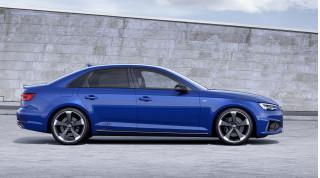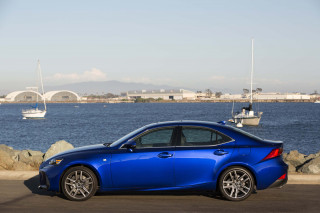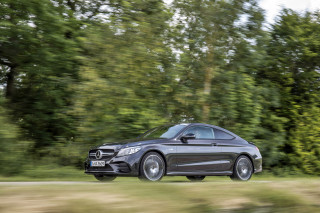Likes
- Evolved looks
- Good standard safety tech
- Impressive technology
- Familiar powertrains
- More to come
Dislikes
- More than $40,000 to start
- Not much more spacious
- No electrified powertrains to start
- Not a dramatic departure
Buying tip
features & specs
The 2019 BMW 330i moves back toward the sweet spot in sport-sedan greatness, with M Sport and M editions still to come.
With the 2019 3-Series, BMW wants to remind the world that it makes the compact sport sedans that define what sport sedans actually are. Nevermind that its own X3 SUV is superior for carrying people, and comes eerily close to the 3-Series performance bogeys of steering and ride—the 3-Series is BMW’s franchise player.
As it veers back more convincingly into sporty territory, we give it a 7.3 out of 10, before the NHTSA has delivered its safety data. (Read more about how we rate cars.)
The 2019 330i and 330xi have to wait to be joined by all the other 3ers to come: A plug-in hybrid 330e, an M340i and M340xi, the M3.
The 3-Series is a car of a thousand faces, from shredder ultra-marathoner to brappy apex-seeker, but the sedan silhouette is common to them all. It’s no dramatic departure. Sure, the crests and kinks are a little more dramatic, the chin a little more prominent, the headlights a bit slimmer, but the 2019 3-Series wants everyone to know who it is from first glance. Where it’s gained is inside. Some of the exuberant wavelike shapes from the i8 have permeated the cabin, the digital displays are on point, and the flourishes of color on the order palette liven up the somber stylings of the base interior.
In this tech-heavy update, BMW’s tried to reverse some of the 3-Series’ mission creep. It’s bigger, yes, but it’s also imbued with more responsive manners. Power still comes from a 2.0-liter turbo-4 pumped here to 255 horsepower; with no manual shifter, power hits the rear or all four wheels off the business end of an 8-speed automatic that snaps to attention in Sport mode, after it pulls out of a deep 2-3 trough. With its independent suspension, the 3-Series offers adaptive dampers and big summer tires, but we found the most composed edition rode on the basic tune with more basic tires. M Sport cars on summer tires deserve the turbo-6 power on the way in the form of the M340i.
Cabin space and support hasn’t changed much, with sport front buckets gripping driver and front passenger like old friends. In back, seat sculpting limits the 3er to two adults for all practical purposes, but two car seats will snap into place and the rear seats fold to boost 17 cubic feet of trunk space.
All 2019 BMW 3-Series cars get standard automatic emergency braking, Bluetooth with audio streaming, power features, and run-flat tires. Apple CarPlay requires option packages and an annual charge after year one, and we’re at a loss for the proper emoji to convey the irritation that comes with that ticky-tack slight. In base trim, the 3-Series is a value at about $41,000—but we understand if you decide it deserves buttery leather, high-powered audio, wide-screen infotainment, and automatic park assist that remembers how you pulled in, and backs out for you, on demand.
2019 BMW 3-Series Styling
The 2019 3-Series doesn’t stray too far from BMW’s new golden mean.
The latest generation of the BMW 3-Series presents few design riddles or mysteries. It’s balanced in overall proportion, overstated in some of its details, but a handsome, low-slung sport sedan from every angle. The cabin’s adopted some glowing cues that elevate its game. In all, we think it’s worth a 7 for styling. (Read more about how we rate cars.)
With a slightly more sporty look than the car it replaces, the 2019 BMW 3-Series massages the usual design elements into a cohesive look. The hood and grille meld more into each other, and the chin looks larger, with more sculpting and wide molded inlets for the fog lights. Thinner headlights come standard as LEDs, but BMW fits its adaptive beams or its matrix-LED “Laserlight” headlights for a fee.
Down the side, the 2019 3-Series puts more distance between the crest stamped into its lower panels and the beltline. The kink at the rear roof pillar is more pronounced; because the rear doors have frameless glass, BMW puts black gloss trim at the back edge to make the roof angles appear more dramatic. It’s clever, as long as you’re standing more than five feet away.
By the way, the new 3-Series comes only in sedan form. Coupes and convertibles have long been 4-Series cars; the wagon and Gran Turismo hatchback carry on in last-generation form, with uncertain futures in the U.S.
Step into the logically framed cockpit, and it’s clear BMW’s adopted some of its i8 thinking into the 3-Series. The dash sits lower, wide digital displays rise to the top. A lovely band of trim wraps around the touchscreen, and all around, BMW’s gone for more visual interest than the usual round meters and flippy switches. The center stack of controls line up on a horizon, the gauges slap the needles through hockey-stick swings, and slim ambient lighting pipes into the door handles and armrests in exuberant waves, as it does in the i8.
2019 BMW 3-Series Performance
BMW extracts ample power from the 2019 330i’s turbo-4, and it steers with more verve.
The 2019 BMW 3-Series builds up the right kind of sport-sedan charm as it drills to higher speeds into tighter corners. It’s quick off the line, and communicative as it does its deep-knee bends, though we have some quibbles with on-center feel and tire/damper specs on our test car.
We think it’s worth an 8, with extra points for its commendable grip and one for its powertrain. (Read more about how we rate cars.)
In 2020, BMW shoppers will be able to pay the upgrade fee for a marvelous turbo-6 in the M340i. For 2019, the sole engine’s a more powerful 2.0-liter turbo-4 than BMW offered in the 2018 model. Rated at 255 horsepower and 295 pound-feet of torque, it’s up 7 and 27, respectively. That peak torque number comes in well below 2,000 rpm, which gives the 3-Series ample grunt off the line, whether it powers the rear wheels in the 330i or all four wheels in the 330xi. BMW pipes in some of the engine’s noise for a more sporty cabin sound, but it’s better savored outside the car than in.
The turbo-4’s coupled to an 8-speed automatic, no manual transmission exists on the order sheet. Likely, a dual-clutch is on hold for the inevitable M3. The automatic’s fine for the unobtrusive daily-drive shifts, though there’s a big step down in revs between second and third gears. It’s best in Sport mode, when the more BMW-like neural connection between your right foot and the transmission’s shift points engages fully. BMW quotes a 0-60 mph time of 5.6 seconds, and says the 2019 330i can reach a 155-mph top speed.
On the ride and handling front, BMW outfits the 3-Series with either a conventional set of struts and links, or with adaptive dampers. We’ve spent most of our time in cars with the M Sport suspension, which lowers ride height and stiffens the shock valving, and wears bigger 19-inch wheels and tires.
With the M Sport pack, the 330i has a tense feel, one that begs for the higher-output engines and jitters a bit on junky roads. It’s somewhere between supple and brittle, thanks to the 19-inch summer tires. It’s better at swallowing larger bumps at higher speeds than it is at dissolving the smaller pits that patter through its wheels into the car. The big wheels also induce some vaguer feel on center, amplified in some way by the enormously thick steering wheel. The variable-ratio steering allows a fair amount of on-center play, and needs to be in Sport mode before that goes away, before the car delivers consistent effort through corners. We’ve driven versions of the 3-Series with smaller 18-inch all-season tires and the trade-off of ride comfort and steering precision made better sense for 330i buyers who don’t dream of the M340i upgrade to come.
2019 BMW 3-Series Comfort & Quality
BMW snips some rear-seat shoulder room, but the 2019 3-Series has abundant space for adults and luggage.
BMW fits wonderfully supportive sport seats in the 2019 330i and 330xi. Two adults have good room in back, but the fifth seat’s a bit of geometry for the car’s overall size.
We think it’s worth a 7 here, with extra points for its roomy trunk and front buckets. (Read more about how we rate cars.)
This year’s 3-Series sits only slightly larger than last year’s model. It’s about two inches longer in wheelbase, at 112.2 inches, and is 0.6 inches wider than before. Overall length checks in at 185.7 inches, and the new 3-Series has a roofline half an inch higher than before.
Interior space is roughly the same. The standard sport seats wear leather upholstery and adjust with a wide range of motion, including the length of the bottom cushion. Along with the tilt and telescope steering, it’s simple for drivers big and small to find a great position behind the wheel, though head room is down by a couple of inches in this generation. Heating and cooling are options in front, as is a finer grade of leather.
The 2019 330i’s rear seats don’t quite fit three adults across, despite the car’s big footprint, compared to its leaner last-century shape. (Eds note: Same.) Head room is fine at 37.6 inches in back, and seat bolsters are firm and well-shaped. It’s the shaping that makes it difficult for three people to sit comfortably; the rear cushions push passengers away from the doors, which helps in side-impact protection but reduces the usability of the back seat. What’s more, the center position belt overlaps the left-side belt when it buckles. BMW does point out that two car seats will fit in back, though, and fold-down access to the trunk boosts its regular, squared-off storage space from its usual 17 cubic feet.
2019 BMW 3-Series Safety
Not all crash-test data has emerged for the 2019 BMW 3-Series, but it still earns a top score.
The NHTSA has not had a chance to crash-test the new 3-Series, but we know enough to give it a 9 out of 10 here. (Read more about how we rate cars.)
For the time being, the IIHS has checked in, and it calls the 2019 3-Series a Top Safety Pick+. Given that and its good outward vision, safety options, and standard safety gear, it's just a federal score away from a perfect 10.
With the 2019 3-Series, BMW’s adopted standard low-speed automatic emergency braking across the board. Any version can be outfitted with active lane control and adaptive cruise control, and a new parking-assistance feature can recall how the 3-Series slid into a parking spot, and can use that information to steer out of the spot.
The 3-Series can be fitted with an active drive control system that can sense when drivers aren’t paying attention, and can alert them while it maintains the car’s lane control.
All 3-Series now come with LED headlights. BMW sells adaptive headlights and its so-called “Laserlight” beams as an option.
2019 BMW 3-Series Features
BMW gives no free love to smartphones, but ladles on the 3-Series options.
With the 2019 3-Series, BMW continues to treat smartphone compatibility as a hostile takeover. But it spreads joy in the form of comprehensive if pricey options. All told, it’s a good value, too.
We give it a 7 for features, knocking it down a point for slapped-on charges for smartphones, but adding points for value, options, and infotainment. (Read more about how we rate cars.)
The base $41,245 3-Series hits showrooms for the 2019 model year with the usual power features, 18-inch wheels with all-season run-flat 225/45 tires, climate control, a sunroof, a split-fold rear seat, power front seats, cruise control, ambient lighting, oak trim, and AM/FM/HD radio with Bluetooth and audio streaming. It also has standard forward-collision warnings with automatic emergency braking, but doesn’t include Apple CarPlay and Android Auto compatibility.
That begins the story of options. BMW offers them by the ream. CarPlay comes with navigation, a head-up display, and heated seats in a $2,800 package, which requires a $2,150 convenience package, but they’re also available with navigation as a $1,600 stand-alone option. After a year, BMW charges $80 annually for its wireless smartphone connection. No other automaker charges those fees.
Other options include $1,700 worth of leather upholstery; a $2,150 bundle with LED headlights, keyless entry, blind-spot monitors, satellite radio, and Active Driving Assistant. Another $1,700 added to that stirs in active lane control, adaptive cruise, and traffic-jam assist. Automatic high beams, a surround-view camera system, gesture controls, and Laserlight headlights come in a $2,100 package.
We’d definitely pitch in for the $5,000 M Sport package and its variable sport steering, 19-inch wheels (225/40 front, 255/35 rear), synthetic leather dash, aluminum or wood trim, and ante up another $700 for adaptive dampers. Track Handling is a $2,450 option that gets M Sport brakes, sport differential, and adaptive dampers.
Stand-alone options include remote start, heated front seats, a power decklid, parking sensors, wood trim, Harman Kardon sound, adaptive cruise control, wireless smartphone charging, and a heated steering wheel.
While we have qualms with the way BMW charges for smartphone connectivity, we like the latest iDrive infotainment system. In base form it combines a 5.7-inch digital display in the dash with an 8.8-inch screen on the center stack; pay more and it gets 12.3-inch digital gauges and a 10.3-inch touchscreen. It’s capable of understanding more natural spoken phrases, can read emails, change temperatures in the cabin, and can even learn your chosen name for it: Instead of “Hey, BMW,” you can beckon it with anything you like, after a short voice-programming run.
2019 BMW 3-Series Fuel Economy
The 3-Series posts impressive fuel economy.
The EPA has published ratings for the 2019 3-Series, and they're good. (Read more about how we rate cars.)
The agency pegs the new 3-Series sedan at 26 mpg city, 36 highway, and 30 combined. It's 25/34/28 mpg with all-wheel drive.
All gas-powered BMWs now come with stop/start to save fuel.















































































































